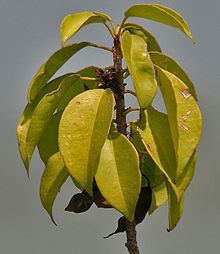Tribe Hippomaneae Scientific name Excoecaria agallocha Rank Species | ||
Similar Excoecaria, Ceriops, Bruguiera, Bruguiera gymnorrhiza, Sonneratia | ||
Octonary ingredients of excoecaria agallocha formulations pankaj oudhia s medicinal plant database
Excoecaria agallocha, a mangrove species, belongs to the genus Excoecaria of the family Euphorbiaceae. It is common in mangrove swamps from Bangladesh, India in the northwest to Australia in the southeast,[2] within Australia, it thrives from northern New South Wales along the northern coastline around to Western Australia. Given such a wide range, it is understandable that the species has many common names including: Thillai, milky mangrove, blind-your-eye mangrove and river poison tree. Most of the names refer to its poisonous or blinding nature.
Mangrove swamps form a type of coastal wetland found in the tropics and subtropics. Within a mangrove forest, the most salt-tolerant species occur near the ocean. Excoecaria agallocha, known as a back mangrove, is found at higher elevations back away from the ocean where salinity is lower.
This small tree species may grow up to 15 m high. Trees are either male or female. Male flowers form drooping tassels, while female flowers appear as shorter spikes. Pollinators such as bees commonly visit the flowers. The fruit is a small dark capsule.[3]

The plant is well-protected by chemical defenses; these include diterpenoids, triterpenoids and flavonoids.
The milky latex of Excoecaria agallocha is very poisonous and powerfully irritant, which is not unusual in milky species of plant in the family Euphorbiaceae. Contact with skin causes irritation and rapid blistering; slight contact with eyes can cause temporary blindness, hence the common names that refer to blindness. Even the generic name is from the Latin for "blinder".
William Bligh in his book "A Voyage to the South Sea" mentioned that he was already aware of this hazard when he embarked on the voyage that ended in the notorious mutiny on the Bounty, having learned of it in 1777 from Captain James Cook during the time that he served as Cook's sailing master. Several of the men that Cook had sent ashore to cut wood had been blinded for a time. He accordingly instructed his men not to cut that type of tree when he sent them ashore in Tahiti to gather wood and water in 1789. It was just as well that he did so, because even the smoke from the burning wood is poisonous and can harm the eyes, so it would not have been useful as fuel.
Even dried and powdered leaves retain the poison and can kill fish very quickly.
Owing to its complex chemistry, the plant may have many new medicinal uses.
Mangroves of this plant surround the ancient Thillai Chidambaram Temple in Tamil Nadu.
